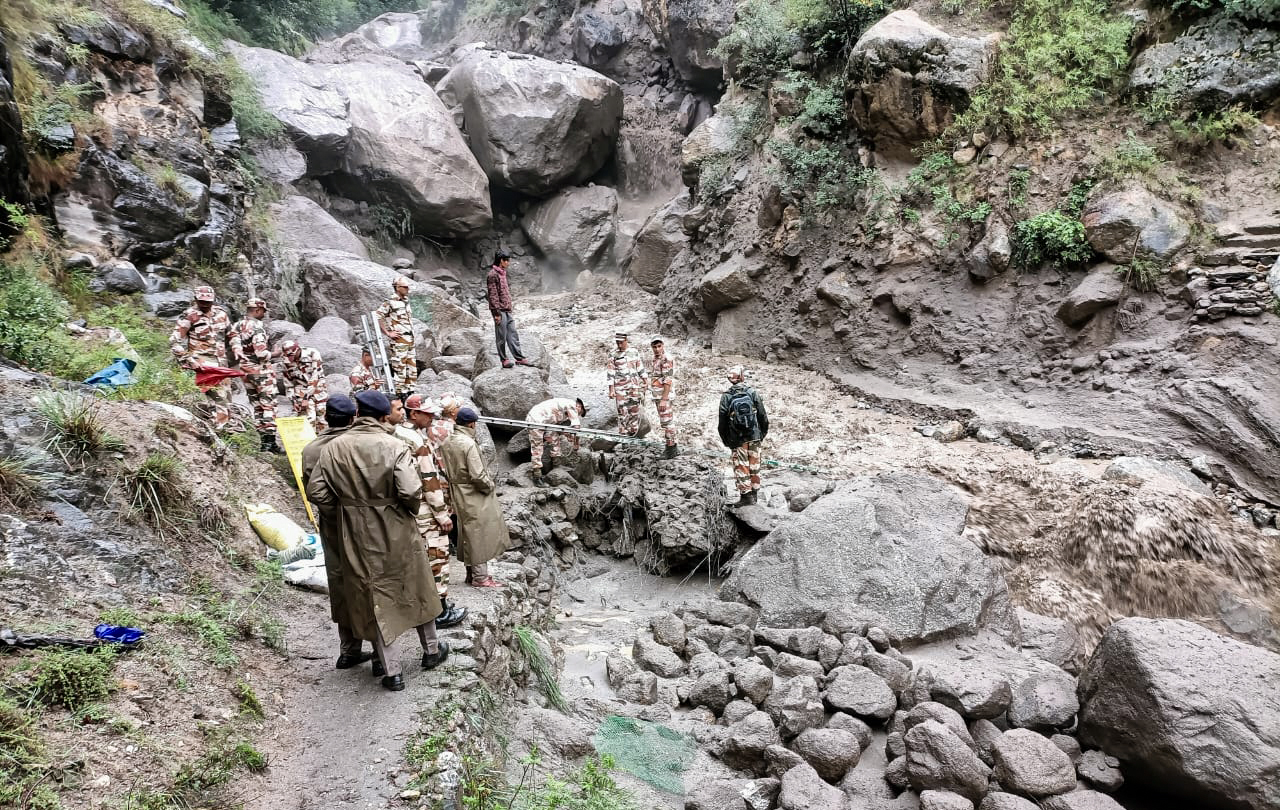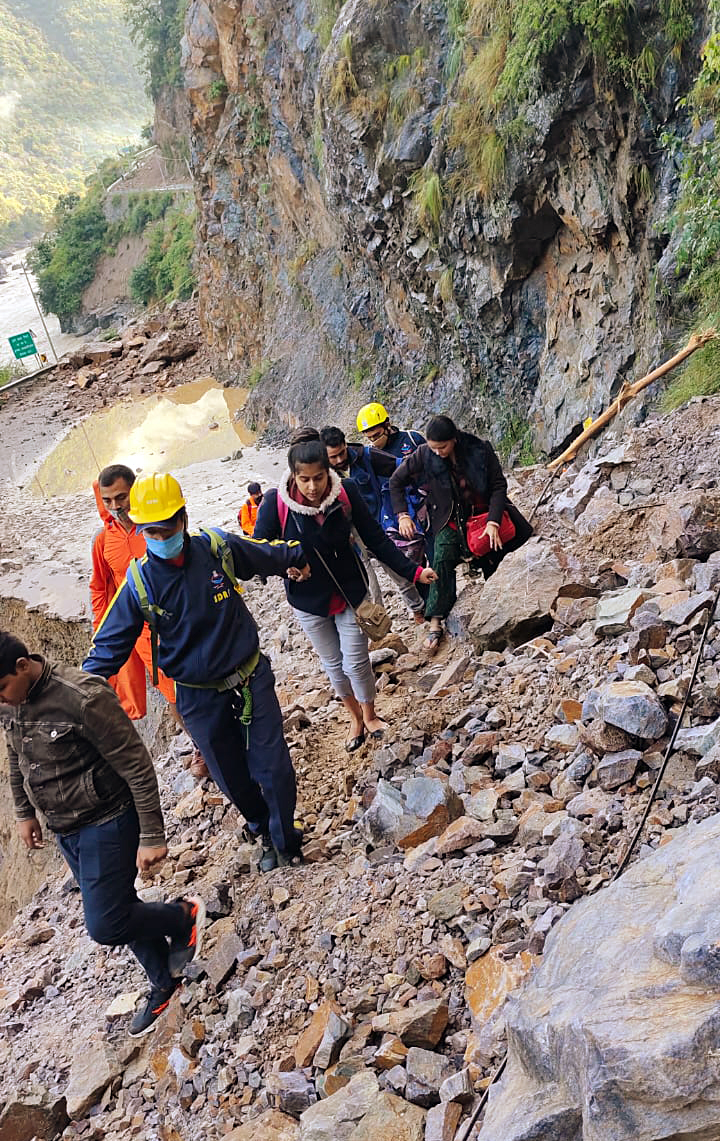.webp)
 Rajeev Narayan
Rajeev Narayan
Last week, I took my monthly drive into India’s mountain roads, my sanctuary of peace, serenity, and solace. I had to return halfway as my tranquil mountains were spitting at me, as the greed of humans had turned them into a macabre theatre of destruction, disaster, and despair. All around, I could see mindless deforestation, haphazard development, and collusion. The writing is loud and clear—tired of being carved out grotesquely, the mountains are hitting back.
Their angry reply is manifested in cloudbursts, flash-floods, glacial melts, and landslides. All of these are now frequent events in Himachal Pradesh, Uttarakhand, Jammu & Kashmir, and the North-East. These calamities have flattened homes, ripped apart highways, snuffed out lives, and buried homes and dreams under mud and debris.
If we speak of Himachal Pradesh, the economic debilitation is startling. Just last week, over 360 roads, including stretches of the Chandigarh-Manali national highway, were washed away or buried under landslides, isolating riverbank communities. Losses in Mandi and Kullu districts are estimated at Rs 1,988 crore. From June 20 to July 10, Himachal Pradesh suffered damages of Rs 750 crore due to illegal or badly-planned constructions near rivers and nullahs.
Other economic blowbacks are also staggering. Uttarakhand’s Dharali town, famous for its apple orchards, was destroyed in under a minute, recurring flash-floods washing the towns and villages away. Most areas were submerged under 30 feet of debris, burying an untold number of people alive, wiping out vast tracts of farmland, and causing hundreds of crores in losses. The pilgrim town of Gangotri Dham faced its tryst with Mother Nature; flash-floods damaged 300 shops and wiped out Rs 100 crore in income and livelihoods.

ITBP team rescuing a pilgrim following a flash flood along the Kinner Kailash Yatra route in Himachal Pradesh
Behind the mounting tragedy lies not only the fury of Climate Change but also the avarice of developers, the collusion of authorities, and the recklessness of human intervention in fragile ecosystems. Mountains are being carved, blasted, and destabilized in the name of progress. But rather than embrace this gross progress, the mountains are spitting back with a vengeance.
The toll of recent weeks alone makes a sobering reading. Early in August, apart from Dharali and Gangotri, Tehri Garhwal and Rudraprayag have also been decimated, landslides sweeping away families and sending tourists scurrying for their lives. In Himachal, a slew of cloudbursts have struck Mandi, Kullu, Kangra, Shimla, and Solan, killing hundreds and leaving thousands untraceable. Mandi saw entire neighbourhoods obliterated, while highways widened two years back were reduced to rubble. These incidents are not isolated acts of nature; they have become a grim and predictable annual reality.
Jammu & Kashmir has been scarred as well. Last week, Chositi village in Kishtwar district was hit by a cloudburst-triggered flood during the Machail Mata pilgrimage. What should have been a spiritual journey turned into a massacre, killing over 63 pilgrims and leaving 300 injured, with a further 200 missing. Makeshift camps, kitchens, security posts, and shelters were swept away in minutes. Just days later, Kathua was hit by landslides that killed 21 people and injured far more. Joshimath and Thathri have turned uninhabitable due to land subsidence, and hundreds have been forced to abandon their ancestral land.
The situation is equally grim in the North-East. In Sikkim, where the glacial outburst flood of 2023 remains etched in memory, the South Lhonak Lake is still bursting regularly, wreaking death and mayhem. Landslides are stemming from ruptures formed in 2023, with the region witnessing a six-fold increase. Over 17,000 landslide-prone sites have been identified, of which 700 are threatening highways, bridges, and human habitation.
In each of these places, the survivors relate hauntingly similar stories: “The skies suddenly split open, walls of water roared down slopes and homes disappeared within moments…” Tellingly, none of these can be attributed to nature’s wrath. These are all direct consequences of human avarice and short-sightedness. Across the Himalayan region, six- and eight-lane highways are being laid to connect tourist hubs like Shimla, Manali, Mussoorie, Nainital, and Srinagar.
To carve wide roads to enable faster tourist cars and arrivals, mountainsides are blasted, forests felled, and natural drainage patterns disrupted. Once the green cover is stripped away, slopes lose stability. The result is that when monsoons arrive, torrents of water carve into exposed soil and loose rock, setting off landslides that sweep away everything in their path. Roads built to make travel faster collapse into valleys, taking with them cars, hotels, entire neighbourhoods… For long, scientists have been warning that road construction would become a major trigger, but their voices were drowned out in the cacophony of contractors and developers.
 SDRF and NDRF personnel rescuing tourist stranded due to the floods in Nainital, Uttarakhand
SDRF and NDRF personnel rescuing tourist stranded due to the floods in Nainital, Uttarakhand
The greed of developers has played a central and destructive role. In Himachal and Uttarakhand, hotels have sprung up on unstable slopes, sans environmental clearances and flouting zoning rules. Worse, resorts and housing societies are being built on the banks of rivers, promising the lure of scenic views for all visitors, defying ecological sense. Such construction is susceptible to even minor flooding, let alone the torrents unleashed by cloudbursts or flash-floods. Come the monsoon, hotels perched precariously along riverbanks are the first to be downed by the raging floodwaters, bringing down not just walls and windows, but also tourists and workers. In most cases, local authorities look the other way.
Hydroelectric projects compound the menace. Dams and tunnels drilled into fragile mountains destabilize slopes, while debris is dumped indiscriminately into valleys and rivers. Together with unplanned urbanization, such reckless development sees heavy downpours increase the risk of a fresh catastrophe. Climate change is accelerating. The Himalayas are warming up at twice the global average, causing glaciers to retreat and increasing lake outbursts. The rising temperature is intensifying rainfall, turning seasonal showers into cloudbursts. Many residents recall that in their youth, monsoons would be slow and steady for months, without the sudden intensity now seen regularly. Today, in the space of an hour, a month’s worth of rain often batters down, overwhelming slopes and sweeping away communities.
The human cost of the environmental collapse is incalculable. Survivors recount how they could only watch as their homes and shops crumbled. Farmers speak of livestock buried under landslides, fields stripped of topsoil, and families left destitute. Parents speak of endless searches for children lost to floodwaters. Tourists return in coffins and with long lists of unanswered questions. Those displaced by subsidence recall how the ground trembled beneath their feet.
This is not development. It is devastation masquerading as progress. Roads, resorts, and hydro-projects built without regard for ecology are becoming monuments to national mockery. Each time the skies open up, exploited ecosystems scream and thunder, warning everyone who has played the deadly ‘Game of Profit’. And when their patience and water-retention limits are breached, the consequences are merciless.
ALSO READ: Safna chose to become a changemaker by becoming an IAS officer
Questions must be asked. When will this madness end? Will governments continue to choose short-term economic gains over long-term ecological survival? Will zoning laws be enforced, or will greedy developers go scot-free? Will villagers remain silent as their ancestral lands crumble beneath their feet? When will India learn to treat the Himalayas not as a playground for reckless construction, but as a vital national ecosystem that sustains and beautifies life?
The writer is a veteran journalist and communications specialist.
